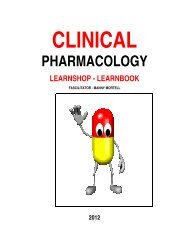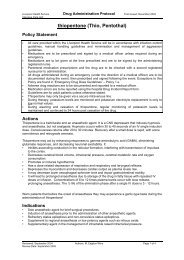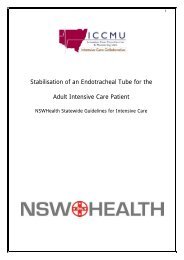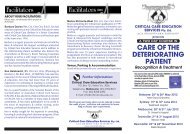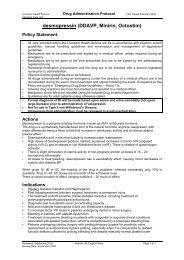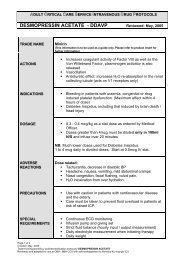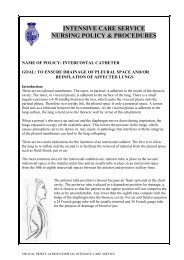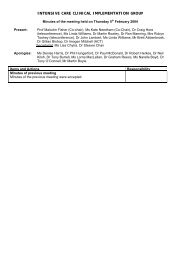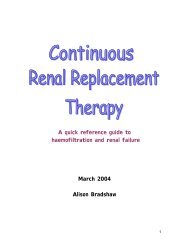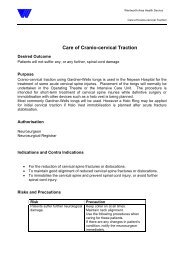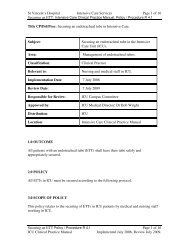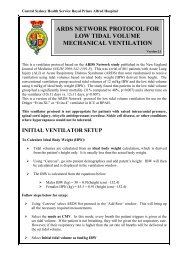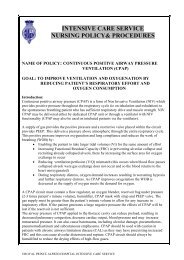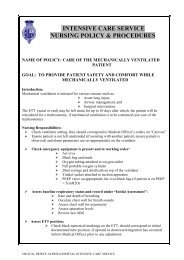Nursing care of the ventilated patient (SWAHS) - Intensive
Nursing care of the ventilated patient (SWAHS) - Intensive
Nursing care of the ventilated patient (SWAHS) - Intensive
Create successful ePaper yourself
Turn your PDF publications into a flip-book with our unique Google optimized e-Paper software.
W e s t e r n<br />
S y d n e y<br />
A re a H e a lth S e rv ic e<br />
H E A L T H<br />
<strong>Nursing</strong> Care Of The Ventilated Patient<br />
<strong>Intensive</strong> Care<br />
Evidence Based Practice Guidelines<br />
2003<br />
• The ETT and o<strong>the</strong>r lines should be safeguarded during turning and <strong>care</strong> should be<br />
taken to ensure that <strong>the</strong>re are no lines or o<strong>the</strong>r equipment under <strong>the</strong> <strong>patient</strong> turned.<br />
• The skin should be kept dry and should be inspected with each change <strong>of</strong> position,<br />
including under restraints. (Refer to Restraints Guideline)<br />
• The head <strong>of</strong> <strong>the</strong> bed should be elevated if <strong>the</strong> <strong>patient</strong>’s condition allows to help<br />
prevent aspiration and improve oxygenation.<br />
• If <strong>the</strong> <strong>patient</strong> has any signs <strong>of</strong> developing pressure areas he/she should be nursed on<br />
an air mattress. (Refer to Pressure Area Care Guideline).<br />
• The ETT should be repositioned at alternate sides <strong>of</strong> <strong>the</strong> mouth to prevent pressure<br />
areas developing.<br />
• The NG tube should be secured in such a way as to minimize pressure on <strong>the</strong> nares<br />
and changed at least daily.<br />
• If <strong>the</strong> <strong>patient</strong> has a hard collar it should be changed to an Aspen collar as soon as<br />
possible and <strong>the</strong> back <strong>of</strong> <strong>the</strong> head and neck checked once a shift for <strong>the</strong> presence <strong>of</strong><br />
pressure areas.<br />
References:<br />
1. Anonymous. (2002) ‘Eye <strong>care</strong> for intensive <strong>care</strong> <strong>patient</strong>s‘, Best Practice Vol 6 (1)<br />
ISSN 1329-1874.<br />
2. Ashurst,S. (1997) ‘<strong>Nursing</strong> <strong>care</strong> <strong>of</strong> <strong>the</strong> mechanically <strong>ventilated</strong> <strong>patient</strong> in ITU: 1,<br />
British Journal <strong>of</strong> <strong>Nursing</strong> Vol 6 (9) Nov, 447-454.<br />
3. Blackwood, B. (1998) ‘The practice and perception <strong>of</strong> intensive <strong>care</strong> staff using <strong>the</strong> closed suction system’,<br />
Journal <strong>of</strong> Advanced <strong>Nursing</strong> Vol 28 (5) Nov,1020-1029.<br />
4. Greifzu, S. (2002) ‘Caring for <strong>the</strong> chronically critically ill’, RN Vol 65 (7) July, 42-44, 46, 48-49.<br />
5. Hickson,S, Sole,M.L, King,T. (98) ‘<strong>Nursing</strong> Strategies to prevent Ventilator-Associated Pneumonia, AACN<br />
Clinical Issues Vol 9 (1) Feb, 76-90.<br />
6. Schwenker,D, Ferrin,M, Gift,A. (1998) ‘A survey <strong>of</strong> Endotracheal suctioning with instillation <strong>of</strong> NaCl’, American<br />
Journal <strong>of</strong> Critical Care Vol 7 (4) 256.<br />
7.Stamm,A.M. (1998) ‘Ventilator- associated pneumonia and frequency <strong>of</strong> circuit changes’, American Journal <strong>of</strong><br />
Infection Control Vol 26 (1) Feb, 71-73.<br />
8. Tan,I.K.S, Oh,T.E.(1997) <strong>Intensive</strong> Care Manual, 4 th ed, p.246, Bath, Butterworth & Heinemann.<br />
Auburn Hospital and Community Health Services • Blacktown Mt Druitt Health Service Cumberland Hospital •<br />
Lottie Stewart Hospital • St Joseph’s Hospital • Westmead Hospital and Community health Services • Parramatta<br />
Linen Services



